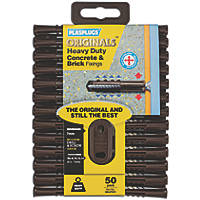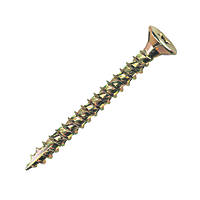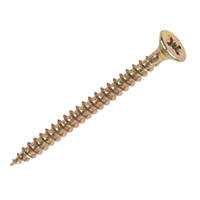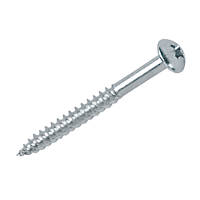We'd like to remind Forumites to please avoid political debate on the Forum... Read More »
📨 Have you signed up to the Forum's new Email Digest yet? Get a selection of trending threads sent straight to your inbox daily, weekly or monthly!
Shelves
SavingStudent1
Posts: 204 Forumite




Hi everyone,
I just bought a shelf that I want to affix to my wall in my room. Now, my wall is a plastered and painted solid brick wall. I bought the shelf from IKEA and they didn't give the screws. I just had some queries regarding how to think about this to get the job done.
The item is: https://www.ikea.com/gb/en/p/lack-wall-shelf-white-50282177/
But, the idea is that it doesn't tell me which screws to use. So, I was wondering, how do I know:
1. Which type of screws I should use? ( for a solid wall, not a dry wall )
2. How long the screws should be?
3. How thick the screws should be?
Once I figure that out, I can always get the corresponding drill bit and wall plug that matches the thickness of the screws. It is because I have never done this before and they didn't supply the screws, so I'm just not sure which ones to use now!
Thank you!
I just bought a shelf that I want to affix to my wall in my room. Now, my wall is a plastered and painted solid brick wall. I bought the shelf from IKEA and they didn't give the screws. I just had some queries regarding how to think about this to get the job done.
The item is: https://www.ikea.com/gb/en/p/lack-wall-shelf-white-50282177/
But, the idea is that it doesn't tell me which screws to use. So, I was wondering, how do I know:
1. Which type of screws I should use? ( for a solid wall, not a dry wall )
2. How long the screws should be?
3. How thick the screws should be?
Once I figure that out, I can always get the corresponding drill bit and wall plug that matches the thickness of the screws. It is because I have never done this before and they didn't supply the screws, so I'm just not sure which ones to use now!
Thank you!
0
Comments
-
You need, preferably, screws with a dome head, but more common flat-head countersink ones will do the job.How thick? IMO, 4mm are fine, but measure the slot size.The length - I'd say 50 mm at least, but make sure that the wall plug is long enough and sits tightly in a brick (preferably) or mortar, not the plaster.And beware, regardless of how well you fix it, the shelf is purely decorative and for light objects only.0
-
Thank you, that really is helpful. May I ask please: How would you know this stuff? Is it from experience and trial and error?grumbler said:You need, preferably, screws with a dome head, but more common flat-head countersink ones will do the job.How thick? IMO, 4mm are fine, but measure the slot size.The length - I'd say 50 mm at least, but make sure that the wall plug is long enough and sits tightly in a brick (preferably) or mortar, not the plaster.And beware, regardless of how well you fix it, the shelf is purely decorative and for light objects only.
1. For example, for a beginner, I don't know what screw to use - would I just know this in the future from doing tasks and experimenting with different screw sizes and thicknesses etc.? Or is it a bit of common sense and having some knowledge of walls and stuff.
2. Also, did you choose thickness of the screws based on the slot size only or also on the wall type?
3. Okay, that makes sense - I am thinking of getting a 30 mm wall plug and 60/70mm screws in that case. Also, if I get a 4mm screw, then does my wall plug need to have 4mm diameter too?
Yes for sure, I understand that and am only using it for light objects, thank you
0 -
Learning what fixings to use is better done by research rather than trial-and-error. YouTube is a good resource - check out Gosforth Handyman's videos on how strong Red wall plugs are:
 https://youtu.be/0Lx7uaboPdw, and his video on tips for using wall plugs:
https://youtu.be/0Lx7uaboPdw, and his video on tips for using wall plugs:  https://youtu.be/TQ13gug7aQ4
https://youtu.be/TQ13gug7aQ4
The screws you need to go into wall plugs are generally described as wood screws. You can get masonry or concrete screws that will screw straight into the bricks if you have a powerful drill/driver. I would suggest that you use wood screws and wall plugs.
The thickness of the screw to use should really be decided based on the quality of the wall and the weight that the screw has to hold (poor walls need bigger and longer screws, heavier weights need a bigger screw), but in your case you will also be limited by the size of the screwhead that you can get to fit into the slots in the Lack shelf brackets. Bigger screws will have bigger screwheads.
So pick the largest screwhead that will go into the slots. If you pop into somewhere like Screwfix or Toolstation, or a local hardware store with one of the brackets, they will probably let you test a few screws from the selection boxes they sell.
Red wall plugs will be suitable for your shelf, and they come on a sprue that normally carries information about the size of drill to use, and the size of screw that should be used with them. The length of the screw should be the length of the wall plug plus the depth of the item that you are fixing the screw through. The brackets are only a few mm thick, and red wall plugs are usually about 30mm long, so a 35mm long screw should be fine, but you should probably go upto 50mm if the plaster seems a bit crumbly. You can stack wall plugs on top of each other in the hole; I cut the excess length off the bottom of the last plug I put into the hole to get it to fit.
You can buy small packs of screws and wall plugs together from stores such as B&Q.
You will need a spirit level to ensure that you put the screws in level - if the screws are level, the shelf will be level. You are likely to need a good drill to drill through the brick. If you don't have one, this would be a good buy Mac Allister MSHD600 600W Electric Impact Drill 240V | Percussion Drills | Screwfix.comThe comments I post are my personal opinion. While I try to check everything is correct before posting, I can and do make mistakes, so always try to check official information sources before relying on my posts.2 -
tacpot12 said: You can buy small packs of screws and wall plugs together from stores such as B&Q.Better still, if you have a B&M store locally, you can pick up packs of Rawplug Uno for just £1.79 and they usually have some small packs of screws as well.Wilko also do a similar range of fixings, all be it, slightly more expensive.. No need to pay the prices that the likes of B&Q charge.Her courage will change the world.
Treasure the moments that you have. Savour them for as long as you can for they will never come back again.1 -
Thanks a lot for this, truly helps! I will take a look at the drill and might purchase it if my original one doesn't do the job, as I have a drill already but it is quite old.tacpot12 said:Learning what fixings to use is better done by research rather than trial-and-error. YouTube is a good resource - check out Gosforth Handyman's videos on how strong Red wall plugs are: https://youtu.be/0Lx7uaboPdw, and his video on tips for using wall plugs:
https://youtu.be/0Lx7uaboPdw, and his video on tips for using wall plugs:  https://youtu.be/TQ13gug7aQ4
https://youtu.be/TQ13gug7aQ4
The screws you need to go into wall plugs are generally described as wood screws. You can get masonry or concrete screws that will screw straight into the bricks if you have a powerful drill/driver. I would suggest that you use wood screws and wall plugs.
The thickness of the screw to use should really be decided based on the quality of the wall and the weight that the screw has to hold (poor walls need bigger and longer screws, heavier weights need a bigger screw), but in your case you will also be limited by the size of the screwhead that you can get to fit into the slots in the Lack shelf brackets. Bigger screws will have bigger screwheads.
So pick the largest screwhead that will go into the slots. If you pop into somewhere like Screwfix or Toolstation, or a local hardware store with one of the brackets, they will probably let you test a few screws from the selection boxes they sell.
Red wall plugs will be suitable for your shelf, and they come on a sprue that normally carries information about the size of drill to use, and the size of screw that should be used with them. The length of the screw should be the length of the wall plug plus the depth of the item that you are fixing the screw through. The brackets are only a few mm thick, and red wall plugs are usually about 30mm long, so a 35mm long screw should be fine, but you should probably go upto 50mm if the plaster seems a bit crumbly. You can stack wall plugs on top of each other in the hole; I cut the excess length off the bottom of the last plug I put into the hole to get it to fit.
You can buy small packs of screws and wall plugs together from stores such as B&Q.
You will need a spirit level to ensure that you put the screws in level - if the screws are level, the shelf will be level. You are likely to need a good drill to drill through the brick. If you don't have one, this would be a good buy Mac Allister MSHD600 600W Electric Impact Drill 240V | Percussion Drills | Screwfix.com
Yes, my plaster is very strong - so I am probably going to use a 35 mm long screw in this case.
You talk about stacking wall plugs on top of each other so that the screw sort of fits inside right? As mostly, a 50 mm screw will be sticking out of the ~ 30mm red wall plug a lot, and to ensure it sticks out just as much as if we used a 35 mm screw, we'd have to use multiple wall plugs and stack them to get them longer and so that the 50mm screw only sticks out a bit. Am I correct in that understanding?0 -
Experience + common senseIn this case:30mm in the brick + plaster, hence 40mm plug and 50mm screw. Possibly, longer if it's mortar and the plug sits less tight than in a brick. The hole has to be slightly deeper than the plug.If a plastic plug is loose in the hole I often use DIY wooden plugs and PVA.Brown plugs take 4.5mm+ screws, not 4mm like I suggested above. So, use 4.5-5.0, but make sure that the head isn't too big for the slot in the brackets.It's worth going to Wilko or BnQ and buying 'pick&mix' bag of screws for £2(?). And you can take the shelf there and check the head size against the bracket (if you cannot do this at home with the screws you have).
1 -
Its a formula based on the weight and value of the items on the shelf, the value of anything below it and how annoyed you'd be it the shelf fell off the wall.SavingStudent1 said:
May I ask please: How would you know this stuff? Is it from experience and trial and error?
1 -
Thanks, yes, I have B&M and Wilko quite close to me, so I will go there and see if I can find the appropriate fixings for a good cost.FreeBear said:tacpot12 said: You can buy small packs of screws and wall plugs together from stores such as B&Q.Better still, if you have a B&M store locally, you can pick up packs of Rawplug Uno for just £1.79 and they usually have some small packs of screws as well.Wilko also do a similar range of fixings, all be it, slightly more expensive.. No need to pay the prices that the likes of B&Q charge.0 -
Thank you, I am thinking of trying it with the screws at home and if not, then taking it to Screwfix, Toolstation or BnQ as recommended and seeing if someone can help me.grumbler said:Experience + common senseIn this case:30mm in the brick + plaster, hence 40mm plug and 50mm screw. Possibly, longer if it's mortar and the plug sits less tight than in a brick. The hole has to be slightly deeper than the plug.If a plastic plug is loose in the hole I often use DIY wooden plugs and PVA.Brown plugs take 4.5mm+ screws, not 4mm like I suggested above. So, use 4.5-5.0, but make sure that the head isn't too big for the slot in the brackets.It's worth going to Wilko or BnQ and buying 'pick&mix' bag of screws for £2(?). And you can take the shelf there and check the head size against the bracket (if you cannot do this at home with the screws you have).
I am planning to do this: get a screw, e.g. 5 mm thick, get the wall plug of the same thickness so the screw is not loose in the wall plug. Then, use a drill bit of the same thickness to create a hole that is the same thickness, so the wall plug won't be loose and will fit right in and be tight.
1. By the way, why you a wall plug be loose in the hole?
2. How do you sort of know if you drilled a hole say 45m deep, do you just drill and put the wall plug in and see if you need more space etc.?
I drew this to show what it'll be like. I feel 10 mm is enough right? Because, if I get too long of a screw compared to the wall plug, e.g. 70 mm for a 40 mm wall plug, then the screw will stick out too much and the wall shelf won't be flat against the wall, but rather it will be hanging like the blue one. The black one is original - it is against the wall, but the blue one is not against the wall as it won't go in fully. I am going off the image on the website where they had the screws sticking out by a bit - probably about the depth of the bracket ~ 10 mm, I assume?0 -
SavingStudent1 said:
I am planning to do this: get a screw, e.g. 5 mm thick, get the wall plug of the same thickness so the screw is not loose in the wall plug.The plug is always thicker. You need 7mm masonry drill bit for brown one.Then, use a drill bit of the same thickness to create a hole that is the same thickness, so the wall plug won't be loose and will fit right in and be tight.
1. By the way, why you a wall plug be loose in the hole?Because mortar between bricks is not as strong as bricks. Even worse, you can be unlucky to hit the edge of a brick and the drill bit will go towards mortar while you need the second hole in a precise position. It's worth using a smaller drill bit first, 6mm in this case, and then use 7mm only if needed.2. How do you sort of know if you drilled a hole say 45m deep, do you just drill and put the wall plug in and see if you need more space etc.?Make a mark on the drill bit first or extract it from the hole and compare to the screw. Nothing wrong if the hole is deeper than needed. If the hole diameter is perfect you normally can't just put the plug into it and need a hammer.I drew this to show what it'll be like. I feel 10 mm is enough right? Because, if I get too long of a screw compared to the wall plug, e.g. 70 mm for a 40 mm wall plug, then the screw will stick out too much and the wall shelf won't be flat against the wall, but rather it will be hanging like the blue one. The black one is original - it is against the wall, but the blue one is not against the wall as it won't go in fully. I am going off the image on the website where they had the screws sticking out by a bit - probably about the depth of the bracket ~ 10 mm, I assume?I don't understand the picture, but for this sort of fixing the distance that the screw sticks out of the wall is a matter of trial and error. Make it smaller gradually until the shelf hangs tightly. The hole depth has to be the same as the screw length or bigger.
1
Confirm your email address to Create Threads and Reply

Categories
- All Categories
- 351.3K Banking & Borrowing
- 253.2K Reduce Debt & Boost Income
- 453.7K Spending & Discounts
- 244.2K Work, Benefits & Business
- 599.4K Mortgages, Homes & Bills
- 177.1K Life & Family
- 257.7K Travel & Transport
- 1.5M Hobbies & Leisure
- 16.2K Discuss & Feedback
- 37.6K Read-Only Boards







